When a Stream Bends and Connects It Eventually Becomes Part of the Stream Again
Identify and describe channel types and sedimentary loads formed and carried by rivers and streams.
In this section, you lot will learn the different types of streams. You will likewise learn the different types of stream loads.
What You'll Larn to Do
- Understand the dissimilar types of rivers and streams, as well equally processes associated with them.
- Understand the processes of erosion and sediment ship and deposition
Types of Streams and Rivers
Streams take a major role in geology. Streams sculpt and shape the globe's surface by eroding, transporting, and depositing sediment. By eroding sediment from uplifted areas and creating landforms made of deposited sediment in lower areas, streams shape the earth's surface more than glaciers exercise, more than waves on a beach do, and far more than wind does.
What Are Streams?
A stream is menstruation of water, driven past gravity, in a natural channel, on land. A small brook in a meadow and the Amazon River are both streams. It is interesting to spotter h2o on a recently bulldozed construction site with a slope. At first the water saturates the ground and begins to flow downhill across the surface of the slope in a thin sail. Soon, the water excavates modest channels, known as rills, in the dirt. Rills coalesce to class larger channels. A network of streams, including tributaries, has formed. If not prevented, the channels may go along to deepen and erode soil from the construction site.
Over longer intervals of time the same processes we've imagined on the construction site have built systems of streams and stream valleys on the surface of the earth. Most valleys on earth are the production of streams. Streams erode clay and rocks, transport the sediment, and redeposit it in new locations, shaping the earth'south surface into a system of stream valleys.
Streams flow downhill due to the force of gravity. The higher the loma, the more gravitational energy there is to drive the stream. Where the slopes are steepest and the hills the highest, the streams volition exist the nigh energetic and the charge per unit of erosion volition be fastest.
Drainage Area
The drainage area of a stream encompasses all the land from which surface runoff flows into that stream. A stream drainage area is also called a watershed. Boundaries betwixt stream drainage areas are called drainage divides. What stream drainage do y'all live in?
Stream Order
It is common for one stream to flow into another. The smaller of the ii streams is a tributary of the larger stream. A stream with no tributaries is a kickoff order stream. A stream with only first-order tributaries is a 2d order stream. A stream that has whatsoever 2nd-club tributaries and none higher is a 3rd-lodge stream, and and then on. The Mississippi River is a 10th lodge stream, one of the highest lodge streams on earth. As more and more than tributaries bring together together a larger stream network is formed and the primary stream, the highest order stream in the organisation has a discharge that is the sum of all the tributary discharges. When flooding occurs, higher order streams have longer to build upward to flood stage than lower lodge streams and longer for the flood to subside.
Drainage Patterns
A stream system that includes multiple tributaries exhibits a distinct drainage pattern as seen on a map. The drainage pattern depends on the stone types and geologic structures underlying the stream organization. Some types of rock are harder and more resistant to erosion than others. If the geology underlying a stream system is fairly uniform—rocks equally resistant to erosion in all directions—a dendritic drainage pattern will develop, as shown in figure 1. A dendritic drainage pattern is the most common type.

Effigy 1
If a region is underlain by layered formations of rock that take been folded, and the layers have different degrees of resistance to erosion, the stream valleys will tend to follow the layers of less resistant rock, and the layers of harder rock will become ridges. This results in a trellis drainage design, as show in effigy ii.

Effigy ii.
In some places the geology consists of a unmarried type of rock that is resistant to erosion but the rock contains sets of parallel joints where it erodes more hands. The sets of joints typically intersect each other at high angles. As stream valleys develop in the joint organization a rectangular drainage pattern develops, every bit shown in figure 3. The stream valleys will curve sharply where they switch from following one joint fix to another.

Figure 3.
Streams will radiate in all directions from the center of a broad, high-elevation area, such as a blended cone. This is known as a radial drainage pattern.
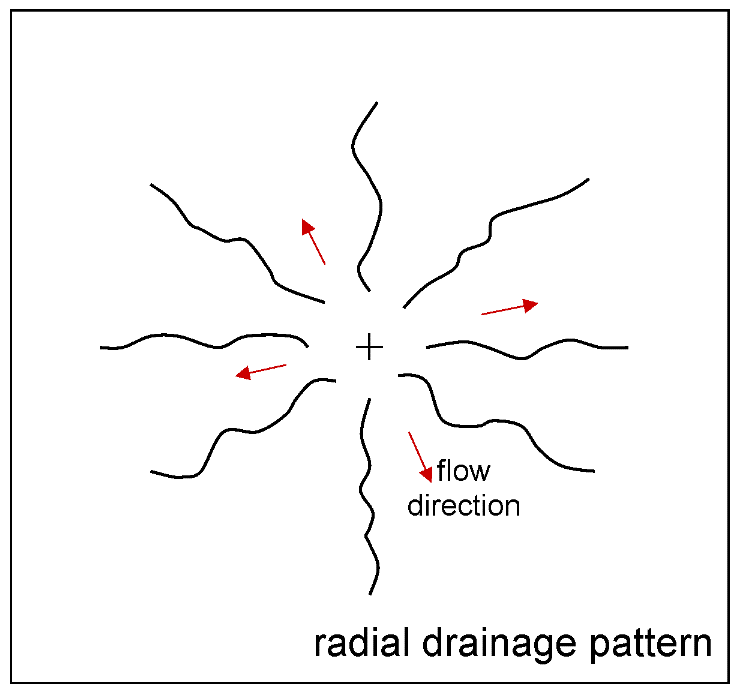
Figure 4.
Graded Contour
Because streams erode more than and remove more sediment where the stream slope is higher, and deposit more sediment where the stream slope is lower, a stream will develop a graded contour equally shown. The graded profile shows how the top of the stream changes along the length of the stream, from its start at the highest top to its base level where it ends at the lowest elevation it reaches.

Figure 5.
A graded profile starts with a steep slope at the outset of the stream and tapers to a gentle gradient at the base level of the stream. Imagine a hiker following a stream up to its beginning and tracking her progress on a topographic map. She starts out where the stream valley is low and wide and the gradient is gentle then the hiking is like shooting fish in a barrel. As the day goes on, the going gets steeper as she approaches the stream source. Checking the topographic map, she sees that the contour lines are much closer together than they were earlier in the mean solar day and farther downwards the valley. As she approaches the small lake on the side of the mount where the stream begins, the gradient is so steep that nearly loses her footing. She has experienced for herself a typical stream profile that steepens from near the base of operations-level to the origin of the stream.
Lakes and waterfalls are temporary features in a stream drainage. If a lake forms the stream feeding it will slow down and deposit sediment until the lake has been filled with sediment. Where a waterfall forms the energy of the stream going over the waterfall is loftier will erode the base of operations of the waterfall, causing the waterfall to retreat upstream until a graded profile is established.
Stream Discharge
The amount of water flowing through a stream and speed at which information technology is moving is expressed as the discharge of the stream. Belch is measured by multiplying the cross-sectional surface area of a stream by the average speed of water through that cross-section. Multiplying the area of the cantankerous-section by the average speed of the water results in units of volume/fourth dimension. For example, if a stream has a cantankerous-sectional area of 150 square anxiety (ft2) and is moving at an average speed of 10 feet per second (ft/south), multiplying the surface area and the speed results in a belch of 1,500 cubic feet per second (ft3/s).
Sediment Load
The h2o flowing in streams erodes, transports, and deposits sediment. Almost rocks and minerals are much denser than water. Sufficient free energy in the stream is required to dislodge rocks from the globe and movement them. The faster a stream flows, the more free energy it has and the larger pieces of sediment it tin can send. The competence of a stream refers to the maximum size of the pieces of sediment it can motility. Faster-moving water has greater competence and can motion larger pieces of sediment.
The capacity of a stream is the full amount of sediment it tin move. Chapters depends on how fast the stream is moving and its total belch. Equally a stream slows downwards, its competence and capacity are reduced. The stream starts to deposit sediment, first with the largest pieces. Several factors cause a stream to slow downward, including the stream channel widening, the stream overflowing its banks and spreading into a floodplain, the stream gradient (downhill slope) diminishing, and the stream emptying into a larger, slower moving trunk of water.
Streams transport clastic sediment in two ways depending on the size of the particles. The coarser sediment is called bed load and consists of particles too large to exist suspended in the moving current of h2o for an extended length of time. The bed load particles, the largest particles of sediment transported by a stream, spend most of their time on the bottom of the stream aqueduct, rolling, sliding, or billowy downstream in fits and starts. The effectively sediment is called suspended load and consists of particles small plenty to exist suspended in the moving electric current of h2o. Suspended load moves at virtually the same charge per unit as the flowing water. In a muddied river, the mud is suspended load
Floodplains
Streams build floodplains through a combination of erosion and deposition at lower gradient stretches of stream valleys. Although a floodplain has a general downhill slope consistent with the overall stream gradient, a floodplain is relatively flat.
Floodplains are filled with sediments spread by the stream. These sediments are known as alluvium. Because alluvium is loose textile that is like shooting fish in a barrel for the stream to erode and redeposit, the location of a stream channel in a floodplain changes frequently.
Meanders
A stream running down a gradient, even the gentle slope of a floodplain, will seldom follow a straight path for very long. Depending on the distribution of sediments and turbulence of the stream, 1 side of the aqueduct may erode more easily than the other. The stream will drift toward the area undergoing erosion, developing a curve in that direction. One time the stream channel has begun to curve, the free energy of the water is full-bodied on the outside of the curve.
The diagram shows a stretch of stream aqueduct with a significant bend, as well known as meander. The blue line shows how erosive energy is concentrated along the exterior of each curve in the stream. As erosion occurs on the outside depository financial institution of a meander, deposition occurs on the inside depository financial institution where the h2o slows and drops sediment.

Figure half dozen.
The diagram below shows two well-developed meanders that have formed in a stream. Along each meander, the outer stream bank that is existence cut into by erosion is called a cut bank. The inner bank, which has grown by accession of deposited sediment, is called a point bar.
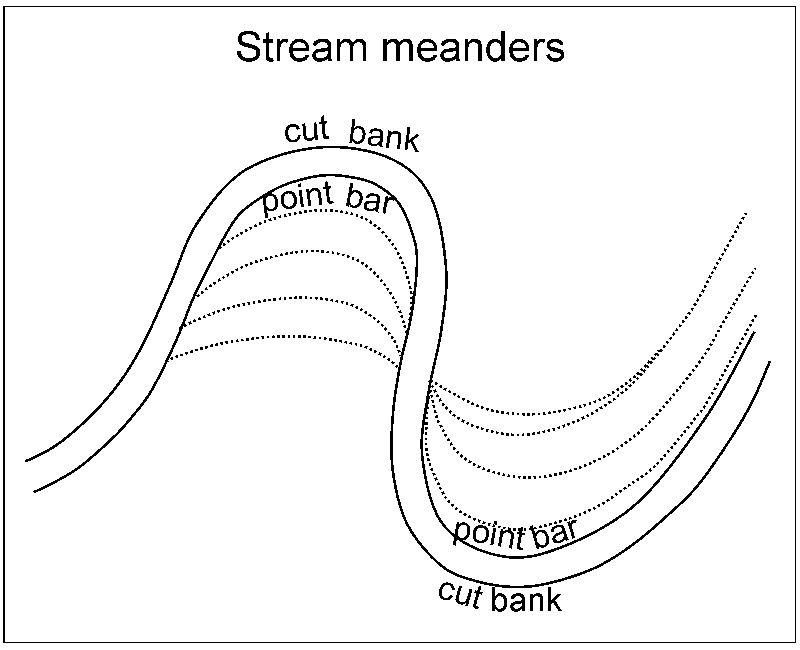
Effigy 7.
In a stream, meanders enlarge and migrate downstream because the stream continually erodes its cut banks and grows its point bars. The diagram below shows the enlargement and downstream migration of a meander in a stream channel. As the meander is enlarged, its neck gets narrower. Eventually, the stream may cut through the neck of the meander, either every bit a result of gradual erosion and channel migration, or abruptly during loftier water and flooding. Once the stream has cut through the neck of the meander, the openings get filled with sediment dropped by water that slows downwardly as it enters from the main stream. The sediment deposits will carve up the cutting off meander from the river aqueduct and turn it into an oxbow lake. As the years go by, the oxbow lake will eventually be completely filled in with sediment because it is a low spot on the floodplain where any water that enters, such as during flooding, will come to a standstill and deposit its sediment load.

Effigy 8.
Entrenched Meanders
Typical meandering stream channels menstruum through broad alluvion plains full of alluvial sediment. However, in some situations meanders may cutting direct into bedrock. A meander that has cutting into boulder is known every bit an incised or entrenched meander. In dissimilarity to meanders in alluvium that erode and migrate rapidly or go cutting off at the cervix abruptly, entrenched meanders are relatively fixed. This is because entrenched meanders are walled in past bedrock on both sides and have petty floodplain to easily erode and redeposit.
Entrenched meanders course every bit a event of tectonic uplift of the stream drainage surface area. The uplift increases the gravity-driven energy of the stream causing information technology to incise rapidly down through the flood plain alluvium into the bedrock below. Entrenched meanders are striking landscape features because they are unusual and they provide potent evidence of tectonic activity in a region. Classic examples of entrenched meanders include the Goosenecks of the San Juan River, which are incised in the Colorado Plateau due east of the Grand Canyon, and a stretch of the Yakima River with entrenched meanders, which are incised in a recently uplifted ridge of basalt in the Columbia Plateau of eastern Washington country.
Braided Streams
Rather than a single channel, some streams accept multiple channels that weave in and out of each other forming what is known equally a braided stream. Braided streams are associated with excessive amounts of sediment entering a stream system. Valleys draining alpine glaciers are common settings for braided streams. The glaciers deposit more sediment into the meltwater stream system than a stream of that belch has capacity to transport in a unmarried channel system. Braided stream systems are indicators that there is an additional source of sediment in the system besides the stream itself. Sources of excess sediment that lead to braided streams include glaciers, eruptions of pyroclastic material by volcanoes and landslides.
Flooding and Flood Frequency
Streams inundation. Flooding is a normal part of stream behavior. The charge per unit at which streams erode, ship, and deposit sediments greatly increases during flooding. A flood occurs when the water depth in a stream exceeds the depth of the stream channel and spreads beyond the stream channel onto the surrounding country. When a stream completely fills its channel it is said to exist at bankfull stage. When a stream surpasses bankfull stage it is said to be in flood. When the flood spreads widely enough to cause property impairment, a stream is said to be at inundation stage.
Unlike streams take different alluvion behaviors. Some rivers tend to accept an annual flood associated with a rainy season or snowmelt flavour in the higher part of the drainage area. Some streams just flood sporadically, oft with years between floods. In the United States all the larger streams have their menstruation measured at gaging stations that are installed and monitored by the U.s. Geological Survey. Records of stream flow must be kept for at to the lowest degree thirty years to exist statistically valid. The likelihood of a alluvion of a specified magnitude occurring on a stream in a given twelvemonth can be calculated from the stream menstruum data. The magnitude of a flood that has a 1 out of 100 chance of happening in a given year—as well known equally the 100-year inundation—is calculated for a stream from it record of stream menstruum. The 100-year inundation magnitude, and maps that show what would be covered by a 100-twelvemonth flood, are central elements in granting permits for land use and edifice structure in floodplains.
Low order streams may alluvion rapidly during or immediately subsequently heavy rainfall. Such rapid floods are called flash floods. Wink floods are frequently unpredictable. If a river drains through a canyon from a high elevation expanse, people may exist walking along a stream in the canyon in the sunshine and not realize that a thunderstorm is occurring at the stream's source. They may be surprised by a flash flood sweeping through the canyon. A slow building flood on a higher social club stream can normally exist predicted because major streams are monitored and information technology takes longer for water from heavy rainfall or rapidly melting snow to move through the higher order stream system. Floods on the highest order streams, such as the Mississippi River, may accept several weeks to crest and subside.
Changes to the land in the drainage area of a stream, such as the addition of buildings and roads, can modify how a stream floods. Buildings and pavement that embrace the footing prevent infiltration and crusade increased surface run off. Increased stream runoff means smaller amount of rain will cause the stream to accomplish flood phase than before the alterations to the land. The stream will flood more frequently. For the aforementioned amount and charge per unit of rainfall that acquired flooding prior to building, the stream will reach alluvion stage quicker and the flood will be deeper. The diagram below shows the flood response of a stream to a given amount of rainfall before and after the stream drainage area was urbanized by removal of woods and addition of buildings and roads. After urbanization, the stream reaches its peak flood level quicker and rises to a higher level than before urbanization. Unless countermeasures are engineered and installed, an urbanized area will flood more frequently and severely than the same area when information technology was forested.

Figure ix.
Alluvial Fans

Figure 10.
At the location where a stream reaches its base level, it slows down and deposits almost all of the sediment information technology is carrying. A stream that comes downward a canyon and enters a flat valley or plain builds a fan shaped eolith of sediment known as an alluvial fan. Alluvial fans are built more often than not during wink floods. Alluvial fans are easy to recognize in arid areas merely they form in wetter climates too.
The diagram in figure xi shows in cantankerous-department how an alluvial fan develops over fourth dimension equally sediment is eroded from higher elevation and deposited on the adjacent lower elevation plain.

Effigy 11.
Deltas
Deltas are of import landforms to civilization. They provide fertile soils, flat country, and water for agronomics, besides equally river channels for transportation.
A delta is a landform composed of sediment deposited where a stream enters a larger, slower moving body of water, such as an ocean, a lake, or a larger river. The term delta comes from the triangular shape of the Greek letter delta (Δ). Aboriginal Greek geographers recognized the triangular shape of the land created by the Nile River where it emptied into the Mediterranean Sea and gave the name delta to that landform. The Nile River delta is one of several types of deltas that are defined by the predominate processes that shape them. The Nile delta is a wave-dominated delta. Waves of the Mediterranean Sea have pushed and distributed sediment along the coast, flattening the seaward side of delta.
The Mississippi River delta is an case of a stream dominated delta. Deposition of sediments has congenital the delta into the Gulf of Mexico faster than waves or tides could redistribute the sediment. As commonly occurs in a delta, the Mississippi River splits in the downstream direction into several branches that belch across the delta into the Gulf of Mexico. These branches are known every bit distributaries. The mouth of each distributary has built part of the delta farther out into the Gulf of Mexico forming what is known equally a bird's foot delta, another proper noun for a stream dominated delta based on the manner it looks on a map.
The Ganges River delta is a tide dominated delta formed from sediment eroded from the Himalaya Mountains, the largest mount range in the earth. The mouth of the Ganges River is at the northern terminate of the Bay of Bengal, a large embayment of the Indian Ocean. The shape of this large bay has a magnifying effect on the tides. The combination of strong tides and the consistently high discharge from a river caring a large sediment load create a branching pattern of distributaries, in effect a braided stream system across the delta.
Deltas are lowlands that prevarication barely higher up sea level and are at loftier gamble of beingness submerged nether water. There are several ways in which deltas tin can exist inundated by rising h2o. Floods coming downwardly the river can cover a delta. Marine deltas tin be field of study to storm surges when extreme winds heighten sea level forth the coast and push bounding main water inland. In the last several decades a new risk of submergence has arisen for marine deltas. Many marine deltas are undergoing gradual submergence as global sea level rises.
Drainage Basins
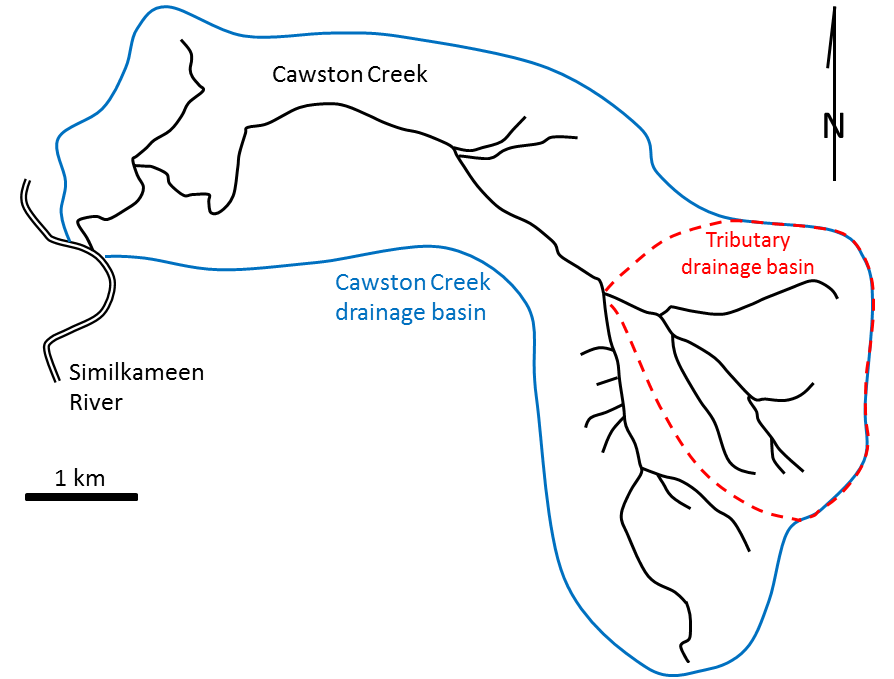
Effigy 12. Cawston Creek nearly Keremeos, B.C. The blue line shows the extent of the drainage basin. The dashed red line is the drainage basin of one of its tributaries. [SE]
A stream is a trunk of flowing surface water of any size, ranging from a tiny trickle to a mighty river. The area from which the h2o flows to form a stream is known as its drainage bowl. All of the precipitation (rain or snow) that falls within a drainage bowl eventually flows into its stream, unless some of that water is able to cross into an adjacent drainage basin via groundwater flow. An example of a drainage basin is shown in Figure 12.
Cawston Creek is a typical small drainage bowl (approximately 25 kmtwo) within a very steep glaciated valley. Every bit shown in Figure thirteen, the upper and centre parts of the creek accept steep gradients (averaging most 200 1000/km but ranging from 100 to 350 chiliad/km), and the lower part, within the valley of the Similkameen River, is relatively apartment (<5 grand/km). The shape of the valley has been controlled first by tectonic uplift (related to plate convergence), then by pre-glacial stream erosion and mass wasting, then by several episodes of glacial erosion, and finally by post-glacial stream erosion. The lowest top of Cawston Creek (275 grand at the Similkameen River) is its base level. Cawston Creek cannot erode below that level unless the Similkameen River erodes deeper into its flood plainly (the area that is inundated during a flood).
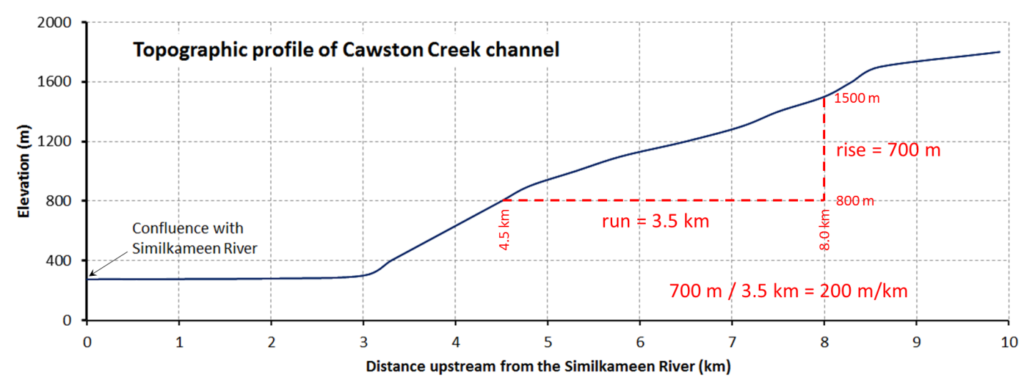
Figure 13. Contour of the main stem of Cawston Creek near Keremeos, B.C. The maximum elevation of the drainage basin is most ane,840 thou, near Mountain Kobau. The base of operations level is 275 m, at the Similkameen River. As shown, the gradient of the stream tin exist adamant by dividing the change in acme between whatever 2 points (rise) by the distance between those two points (run). [SE]
Metro Vancouver's water supply comes from 3 large drainage basins on the northward shore of Burrard Inlet. The boundary betwixt two drainage basins is the summit of land between them. A drib of h2o falling on the boundary between the Capilano and Seymour drainage basins (a.k.a., watersheds), for example, could menstruation into either ane of them.
The pattern of tributaries within a drainage basin depends largely on the type of rock beneath, and on structures inside that stone (folds, fractures, faults, etc.). The three chief types of drainage patterns are illustrated in Figure 14. Dendritic patterns, which are by far the most common, develop in areas where the rock (or unconsolidated material) below the stream has no particular fabric or structure and can be eroded equally hands in all directions. Examples would exist granite, gneiss, volcanic rock, and sedimentary rock that has not been folded. Most areas of British Columbia accept dendritic patterns, every bit practise almost areas of the prairies and the Canadian Shield. Trellis drainage patterns typically develop where sedimentary rocks accept been folded or tilted and and then eroded to varying degrees depending on their force. The Rocky Mountains of B.C. and Alberta are a skilful case of this, and many of the drainage systems within the Rockies have trellis patterns. Rectangularpatterns develop in areas that have very little topography and a system of bedding planes, fractures, or faults that form a rectangular network. Rectangular drainage patterns are rare in Canada.
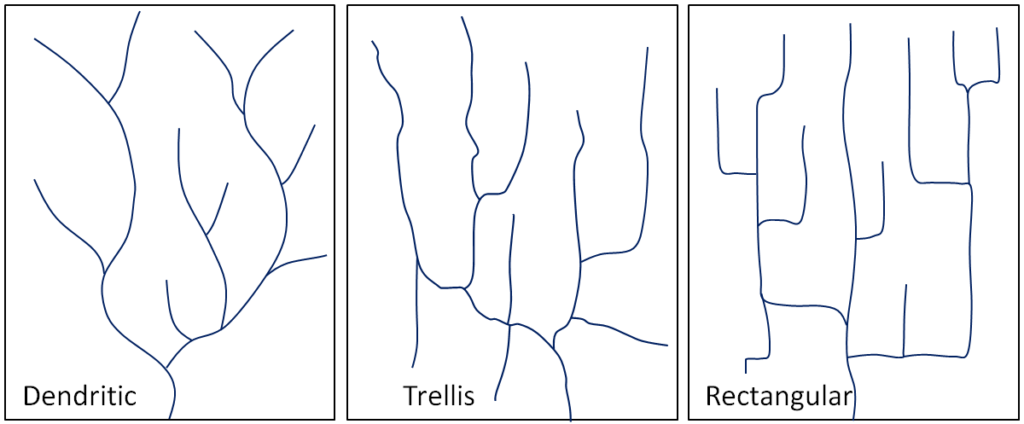
Effigy xiv. Typical dendritic, trellis, and rectangular stream drainage patterns. [SE]
In many parts of Canada, especially relatively flat areas with thick glacial sediments, and throughout much of Canadian Shield in eastern and central Canada, drainage patterns are chaotic, or what is known as deranged(Figure fifteen, left). Lakes and wetlands are common in this type of surroundings. A fourth type of drainage pattern, which is non specific to a drainage basin, is known equally radial (Figure 15, right). Radial patterns course effectually isolated mountains (such equally volcanoes) or hills, and the private streams typically take dendritic drainage patterns.
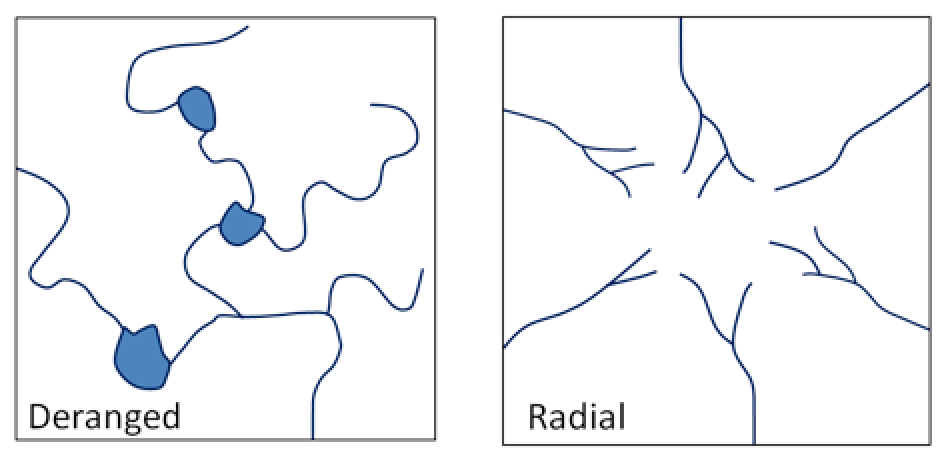
Figure 15. Left: a typical deranged design; right: a typical radial drainage pattern developed around a mountain or hill. [SE]
Over geological time, a stream volition erode its drainage basin into a smooth profile like to that shown in Figure 16. If we compare this with an ungraded stream like Cawston Creek (Figure 12), we can run across that graded streams are steepest in their headwaters and their gradient gradually decreases toward their mouths. Ungraded streams accept steep sections at various points, and typically have rapids and waterfalls at numerous locations forth their lengths.

Effigy 16. The topographic profile of a typical graded stream. [SE]
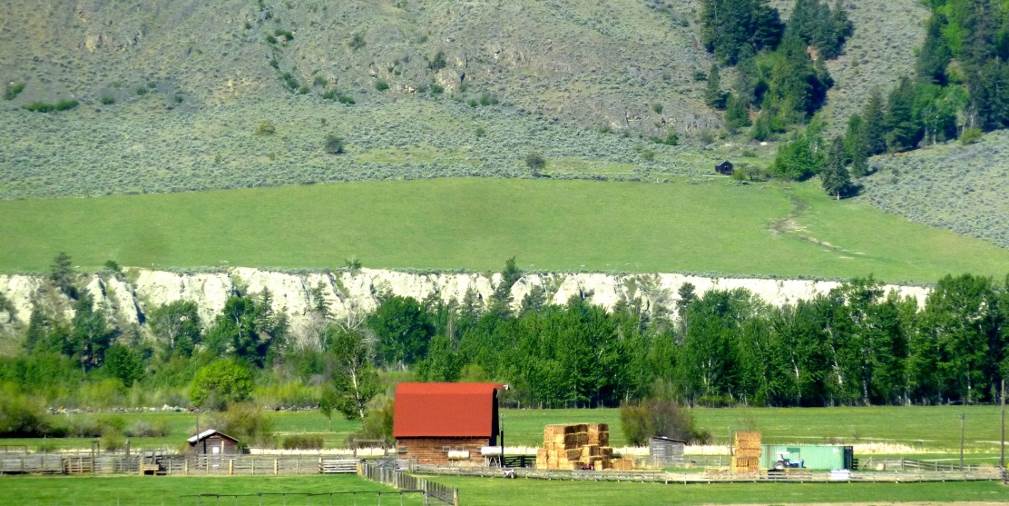
Figure 17. An example of a change in the base of operations level of a small stream that flows into the Similkameen river virtually Keremeos. The previous base level was nearly the peak of the sandy depository financial institution. The electric current base level is the river. [SE]
A graded stream can become ungraded if at that place is renewed tectonic uplift, or if there is a change in the base level, either because of tectonic uplift or some other reason. Every bit stated earlier, the base level of Cawston Creek is defined past the level of the Similkameen River, but this can change, and has washed so in the past. Figure 17 shows the valley of the Similkameen River in the Keremeos area. The river channel is just beyond the row of trees. The green field in the distance is underlain by cloth eroded from the hills behind and deposited by a small creek (not Cawston Creek) adjacent to the Similkameen River when its level was higher than it is now. Old in the past several centuries, the Similkameen River eroded downward through these deposits (forming the steep bank on the other side of the river), and the base of operations level of the pocket-sized creek was lowered by near ten m. Over the adjacent few centuries, this creek will seek to become graded again by eroding down through its ain alluvial fan.
Another example of a alter in base level can be seen along the Juan de Fuca Trail on southwestern Vancouver Island. As shown in Figure 18, many of the small streams along this part of the coast flow into the ocean as waterfalls. Information technology is evident that the land in this area has risen by well-nigh v chiliad in the past few yard years, probably in response to deglaciation. The streams that used to flow directly into the ocean at present have a lot of downwardly-cutting to practise to get regraded.
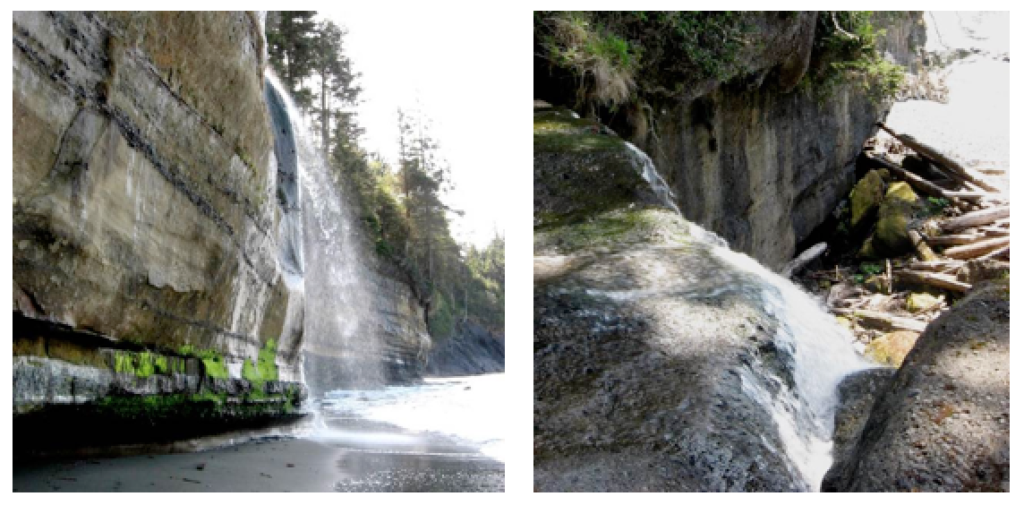
Figure 18. 2 streams with a lowered base of operations level on the Juan de Fuca Trail, southwestern Vancouver Island. [SE]
The ocean is the ultimate base of operations level, just lakes and other rivers human activity as base levels for many smaller streams. Nosotros tin create an artificial base of operations level on a stream by constructing a dam.
Exercise:The Effect of a Dam on Base Level
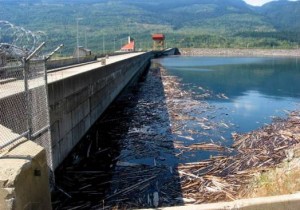
Figure 19. Revelstoke Dam and Revelstoke Lake on the Columbia River at Revelstoke, BC [SE]
When a dam is built on a stream, a reservoir (bogus lake) forms behind the dam, and this temporarily (for many decades at least) creates a new base of operations level for the role of the stream above the reservoir.
- How does the formation of a reservoir affect the stream where it enters the reservoir, and what happens to the sediment it was carrying?
- The water leaving the dam has no sediment in it. How does this affect the stream beneath the dam?
Take a moment to retrieve about your answers to these questions. Yous tin tape them in the space below, if you'd like:
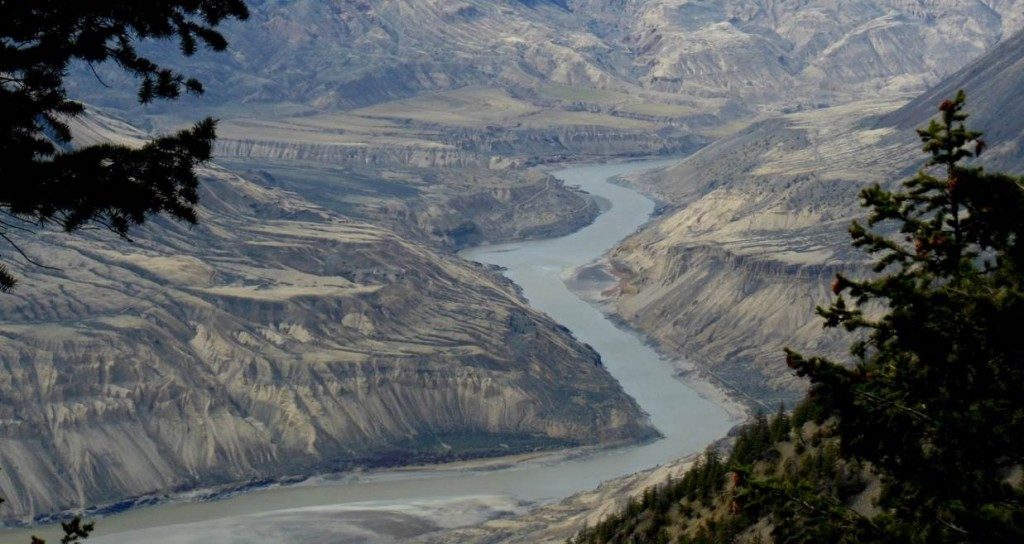
Figure twenty. Terraces on the Fraser River at High Bar. [Marie Betcher photograph, used with permission]
Sediments accumulate within the flood plain of a stream, and then, if the base level changes, or if there is less sediment to deposit, the stream may cut downwardly through those existing sediments to form terraces. A terrace on the Similkameen River is shown in Figure 17 and some on the Fraser River are shown in Effigy xx. The Fraser River photo shows at least two levels of terraces.
In the tardily nineteenth century, American geologist William Davis proposed that streams and the surrounding terrain develop in a cycle of erosion (Effigy 21). Following tectonic uplift, streams erode chop-chop, developing deep V-shaped valleys that tend to follow relatively straight paths. Gradients are loftier, and profiles are ungraded. Rapids and waterfalls are common. During the mature stage, streams erode wider valleys and start to deposit thick sediment layers. Gradients are slowly reduced and grading increases. In quondam age, streams are surrounded by rolling hills, and they occupy wide sediment-filled valleys. Meandering patterns are common.
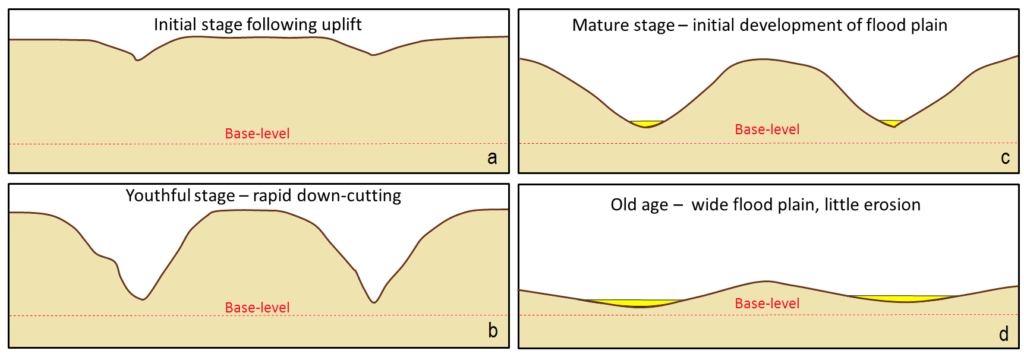
Figure 21. A depiction of the Davis bicycle of erosion: a: initial stage, b: youthful stage, c: mature phase, and d: old historic period. [SE]
Davis's work was washed long before the idea of plate tectonics, and he was not familiar with the impacts of glacial erosion on streams and their environments. While some parts of his theory are out of date, it is still a useful way to empathize streams and their evolution.
Geologic Processes and Flowing Water

Figure 22. As streams flow towards the sea, they carry weathered materials.
Streams—whatever running water from a rivulet to a raging river—complete the hydrologic cycle by returning precipitation that falls on land to the oceans (figure 22). Some of this water moves over the surface and some moves through the basis as groundwater. Flowing water does the work of both erosion and deposition.
Erosion and Degradation by Streams
Erosion by Streams
Flowing streams pick up and send weathered materials past eroding sediments from their banks. Streams also carry ions and ionic compounds that dissolve easily in the water. Sediments are carried every bit:
- Dissolved load: Dissolved load is composed of ions in solution. These ions are ordinarily carried in the water all the way to the ocean.

Figure 23. Rivers behave sand, silt and clay as suspended load. During flood stage, the suspended load profoundly increases as stream velocity increases.
- Suspended load: Sediments carried as solids as the stream flows are suspended load. The size of particles that tin can exist carried is determined by the stream'south velocity (figure 23). Faster streams tin deport larger particles. Streams that acquit larger particles accept greater competence. Streams with a steep gradient (slope) have a faster velocity and greater competence.
- Bed load: Particles that are likewise big to be carried as suspended load are bumped and pushed forth the stream bed every bit bed load. Bed load sediments practise not move continuously. This intermittent movement is called saltation. Streams with high velocities and steep gradients do a great deal of downwards cutting into the stream bed, which is primarily accomplished by movement of particles that make up the bed load.
- Hither is a video of bedload transport.
Stages of Streams
Every bit a stream flows from higher elevations, like in the mountains, towards lower elevations, like the body of water, the work of the stream changes. At a stream'southheadwaters, often loftier in the mountains, gradients are steep (figure 24). The stream moves fast and does lots of work eroding the stream bed.

Figure 24. This stream begins as snow melt from the mountains.
As a stream moves into lower areas, the gradient is not as steep. Now the stream does more work eroding the edges of its banks. Many streams develop curves in their channels called meanders (figure 25).

Figure 25. (a) At a meander, a stream actively erodes its outer banks and deposits fabric forth the inside curves. This causes these meanders to migrate laterally over time. (b) This stream has deposited larger materials such every bit gravel and pebbles along the inside curve of a meander. (c) This image is a topographic map. The San Juan River eroded the land surface as the Colorado Plateau uplifted. The river's meanders were preserved as a characteristic called incised meanders.
As the river moves onto flatter ground, the stream erodes the outer edges of its banks to carve a floodplain, which is a flat level area surrounding the stream channel (figure 26).

Effigy 26. The Vistula River in Poland flows onto its floodplain.
Base of operations level is where a stream meets a big trunk of continuing water, usually the ocean, but sometimes a lake or pond. Streams work to downwards cut in their stream beds until they reach base level. The higher the tiptop, the farther the stream is from where it will reach base level and the more than cutting it has to do.
Stream Degradation
As a stream gets closer to base level, its gradient lowers and it deposits more than material than it erodes. On flatter ground, streams eolith material on the inside of meanders. Placer mineral deposits, described in the Earth'south Minerals affiliate, are oft deposited there. A stream'southward floodplain is much broader and shallower than the stream's channel. When a stream flows onto its floodplain, its velocity slows and information technology deposits much of its load. These sediments are rich in nutrients and make excellent farmland (figure 27).

Figure 27. The Mississippi floodplain is heavily farmed. Flooding tin wipe out farms and towns, but the stream as well deposits nutrient-rich sediments that enrich the floodplain.
A stream at alluvion stage carries lots of sediments. When its slope decreases, the stream overflows its banks and broadens its aqueduct. The decrease in gradient causes the stream to deposit its sediments, the largest get-go. These big sediments build a higher area around the edges of the stream aqueduct, creating natural levees (figure 28).

Figure 28. After many floods, a stream builds natural levees along its banks.
When a river enters continuing water, its velocity slows to a end. The stream moves back and along beyond the region and drops its sediments in a wide triangular-shaped deposit called a delta (figure 29).

Figure 29. (a) The Nile River delta has a classic triangular shape, like the upper-case letter Greek letter delta. (b) Sediment in the Yellowish River delta. The master stream channel splits into many smaller distributaries.
If a stream falls down a steep gradient onto a broad flat valley, an alluvial fandevelops (figure 30). Alluvial fans mostly course in barren regions.

Figure 30. An alluvial fan in Iran. The mountains are in the lower right corner of the photograph.
Check Your Understanding
Answer the question(s) below to see how well you understand the topics covered in the previous section. This short quiz doesnon count toward your class in the class, and you can retake it an unlimited number of times.
Apply this quiz to check your understanding and decide whether to (1) study the previous department farther or (2) move on to the next department.
Source: https://courses.lumenlearning.com/wmopen-geology/chapter/outcome-rivers-and-streams/
0 Response to "When a Stream Bends and Connects It Eventually Becomes Part of the Stream Again"
Postar um comentário